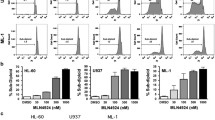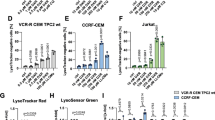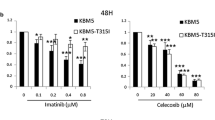Abstract
Gemtuzumab ozogamicin (GO), an anti-CD33 antibody linked to calicheamicin via an acid-labile linker, is the first antibody–drug conjugate (ADC). The acidic environment inside lysosomes of target cells is an important intracellular determinant of the cytocidal action of GO, as the linker is hydrolyzed under acidic conditions. However, lysosomal activity in acute myeloid leukemia (AML) blasts in GO therapy has been insufficiently evaluated. It has been suggested that lysosome activity is suppressed in AML due to hyperactivation of the phosphoinositide 3-kinase/Akt pathway. We therefore hypothesized that agents which activate lysosomal function would potentiate the cytotoxicity of GO. Here, we found that a clinically useful mTORC1/2 dual inhibitor, AZD2014, reduced pH in the acidic organelles, including lysosomes, as shown by increased LysoTracker fluorescent intensity, and synergistically enhanced the cytotoxic effect of GO in primary leukemia cells. GO-induced cytotoxicity appeared to be enhanced with the increase in lysosomal activity by AZD2014. These results indicate that AZD2014 activated lysosomal function in primary leukemia cells, which in turn enhanced the cytotoxicity of GO. Enhancement of lysosomal activity may represent a new therapeutic strategy in the treatment of GO and other ADCs, particularly in cases with low lysosomal activity.




Similar content being viewed by others

References
Fernandez HF, Sun Z, Yao X, Litzow MR, Luger SM, Paietta EM, et al. Anthracycline dose intensification in acute myeloid leukemia. N Engl J Med. 2009;361:1249–59.
Robak T, Wierzbowska A. Current and emerging therapies for acute myeloid leukemia. Clin Ther. 2009;31(Pt 2):2349–70.
Rollig C, Bornhauser M, Thiede C, Taube F, Kramer M, Mohr B, et al. Long-term prognosis of acute myeloid leukemia according to the new genetic risk classification of the European LeukemiaNet recommendations: evaluation of the proposed reporting system. J Clin Oncol. 2011;29:2758–65.
Schaich M, Rollig C, Soucek S, Kramer M, Thiede C, Mohr B, et al. Cytarabine dose of 36 g/m(2) compared with 12 g/m(2) within first consolidation in acute myeloid leukemia: results of patients enrolled onto the prospective randomized AML96 study. J Clin Oncol. 2011;29:2696–702.
Hamann PR, Hinman LM, Hollander I, Beyer CF, Lindh D, Holcomb R, et al. Gemtuzumab ozogamicin, a potent and selective anti-CD33 antibody-calicheamicin conjugate for treatment of acute myeloid leukemia. Bioconjugate Chem. 2002;13:47–58.
Godwin CD, Gale RP, Walter RB. Gemtuzumab ozogamicin in acute myeloid leukemia. Leukemia. 2017;31:1855–68.
Walter RB, Appelbaum FR, Estey EH, Bernstein ID. Acute myeloid leukemia stem cells and CD33-targeted immunotherapy. Blood. 2012;119:6198–208.
Larson RA, Sievers EL, Stadtmauer EA, Lowenberg B, Estey EH, Dombret H, et al. Final report of the efficacy and safety of gemtuzumab ozogamicin (Mylotarg) in patients with CD33-positive acute myeloid leukemia in first recurrence. Cancer. 2005;104:1442–52.
Giles F, Estey E, O’Brien S. Gemtuzumab ozogamicin in the treatment of acute myeloid leukemia. Cancer. 2003;98:2095–104.
Petersdorf SH, Kopecky KJ, Slovak M, Willman C, Nevill T, Brandwein J, et al. A phase 3 study of gemtuzumab ozogamicin during induction and postconsolidation therapy in younger patients with acute myeloid leukemia. Blood. 2013;121:4854–60.
Ricart AD. Antibody–drug conjugates of calicheamicin derivative: gemtuzumab ozogamicin and inotuzumab ozogamicin. Clin Cancer Res. 2011;17:6417–27.
Chalouni C, Doll S. Fate of antibody–drug conjugates in cancer cells. J Exp Clin Cancer Res. 2018;37:20.
LaMarr WA, Yu L, Nicolaou KC, Dedon PC. Supercoiling affects the accessibility of glutathione to DNA-bound molecules: positive supercoiling inhibits calicheamicin-induced DNA damage. Proc Natl Acad Sci USA. 1998;95:102–7.
Laszlo GS, Estey EH, Walter RB. The past and future of CD33 as therapeutic target in acute myeloid leukemia. Blood Rev. 2014;28:143–53.
Saftig P, Klumperman J. Lysosome biogenesis and lysosomal membrane proteins: trafficking meets function. Nat Rev Mol Cell Biol. 2009;10:623–35.
Settembre C, Zoncu R, Medina DL, Vetrini F, Erdin S, Erdin S, et al. A lysosome-to-nucleus signalling mechanism senses and regulates the lysosome via mTOR and TFEB. EMBO J. 2012;31:1095–108.
Evangelisti C, Evangelisti C, Chiarini F, Lonetti A, Buontempo F, Neri LM, et al. Autophagy in acute leukemias: a double-edged sword with important therapeutic implications. Biochim Biophys Acta. 2015;1853:14–26.
Nyakern M, Tazzari PL, Finelli C, Bosi C, Follo MY, Grafone T, et al. Frequent elevation of Akt kinase phosphorylation in blood marrow and peripheral blood mononuclear cells from high-risk myelodysplastic syndrome patients. Leukemia. 2006;20:230–8.
Follo MY, Mongiorgi S, Bosi C, Cappellini A, Finelli C, Chiarini F, et al. The Akt/mammalian target of rapamycin signal transduction pathway is activated in high-risk myelodysplastic syndromes and influences cell survival and proliferation. Cancer Res. 2007;67:4287–94.
Tamburini J, Elie C, Bardet V, Chapuis N, Park S, Broet P, et al. Constitutive phosphoinositide 3-kinase/Akt activation represents a favorable prognostic factor in de novo acute myelogenous leukemia patients. Blood. 2007;110:1025–8.
Zhang H. Targeting autophagy in lymphomas: a double-edged sword? Int J Hematol. 2018;107:502–12.
Watson AS, Riffelmacher T, Stranks A, Williams O, De Boer J, Cain K, et al. Autophagy limits proliferation and glycolytic metabolism in acute myeloid leukemia. Cell Death Discov. 2015;1:15008.
Liao H, Huang Y, Guo B, Liang B, Liu X, Ou H, et al. Dramatic antitumor effects of the dual mTORC1 and mTORC2 inhibitor AZD2014 in hepatocellular carcinoma. Am J Cancer Res. 2015;5:125–39.
Basu B, Dean E, Puglisi M, Greystoke A, Ong M, Burke W, et al. First-in-human pharmacokinetic and pharmacodynamic study of the dual m-TORC 1/2 inhibitor AZD2014. Clin Cancer Res. 2015;21:3412–9.
Maimaitili Y, Inase A, Miyata Y, Kitao A, Mizutani Y, Kakiuchi S, et al. An mTORC1/2 kinase inhibitor enhances the cytotoxicity of gemtuzumab ozogamicin by activation of lysosomal function. Leuk Res. 2018;74:68–74.
Klco JM, Spencer DH, Lamprecht TL, Sarkaria SM, Wylie T, Magrini V, et al. Genomic impact of transient low-dose decitabine treatment on primary AML cells. Blood. 2013;121:1633–43.
Weir MC, Hellwig S, Tan L, Liu Y, Gray NS, Smithgall TE. Dual inhibition of Fes and Flt3 tyrosine kinases potently inhibits Flt3-ITD+ AML cell growth. PLoS One. 2017;12:e0181178.
Wu Y, Giaisi M, Kohler R, Chen WM, Krammer PH, Li-Weber M. Rocaglamide breaks TRAIL-resistance in human multiple myeloma and acute T-cell leukemia in vivo in a mouse xenograft model. Cancer Lett. 2017;389:70–7.
Foucquier J, Guedj M. Analysis of drug combinations: current methodological landscape. Pharmacol Res Perspect. 2015;3:e00149.
Kim SK, Im GJ, An YS, Lee SH, Jung HH, Park SY. The effects of the antioxidant alpha-tocopherol succinate on cisplatin-induced ototoxicity in HEI-OC1 auditory cells. Int J Pediatr Otorhinolaryngol. 2016;86:9–14.
Scott RC, Schuldiner O, Neufeld TP. Role and regulation of starvation-induced autophagy in the Drosophila fat body. Dev Cell. 2004;7:167–78.
Rodriguez-Enriquez S, Kim I, Currin RT, Lemasters JJ. Tracker dyes to probe mitochondrial autophagy (mitophagy) in rat hepatocytes. Autophagy. 2006;2:39–46.
Kurimoto M, Matsuoka H, Hanaoka N, Uneda S, Murayama T, Sonoki T, et al. Pretreatment of leukemic cells with low-dose decitabine markedly enhances the cytotoxicity of gemtuzumab ozogamicin. Leukemia. 2013;27:233–5.
Amico D, Barbui AM, Erba E, Rambaldi A, Introna M, Golay J. Differential response of human acute myeloid leukemia cells to gemtuzumab ozogamicin in vitro: role of Chk1 and Chk2 phosphorylation and caspase 3. Blood. 2003;101:4589–97.
Zhou J, Tan SH, Nicolas V, Bauvy C, Yang ND, Zhang J, et al. Activation of lysosomal function in the course of autophagy via mTORC1 suppression and autophagosome-lysosome fusion. Cell Res. 2013;23:508–23.
Selvarajah J, Elia A, Carroll VA, Moumen A. DNA damage-induced S and G2/M cell cycle arrest requires mTORC2-dependent regulation of Chk1. Oncotarget. 2015;6:427–40.
Musa F, Alard A, David-West G, Curtin JP, Blank SV, Schneider RJ. Dual mTORC1/2 inhibition as a novel strategy for the resensitization and treatment of platinum-resistant ovarian cancer. Mol Cancer Ther. 2016;15:1557–67.
Saeki K, Okuma E, Yuo A. Recurrent growth factor starvation promotes drug resistance in human leukaemic cells. Br J Cancer. 2002;86:292–300.
Takeshita A. Efficacy and resistance of gemtuzumab ozogamicin for acute myeloid leukemia. Int J Hematol. 2013;97:703–16.
Folkerts H, Hilgendorf S, Wierenga ATJ, Jaques J, Mulder AB, Coffer PJ, et al. Inhibition of autophagy as a treatment strategy for p53 wild-type acute myeloid leukemia. Cell Death Dis. 2017;8:e2927.
Heydt Q, Larrue C, Saland E, Bertoli S, Sarry JE, Besson A, et al. Oncogenic FLT3-ITD supports autophagy via ATF4 in acute myeloid leukemia. Oncogene. 2018;37:787–97.
Jawad M, Seedhouse C, Mony U, Grundy M, Russell NH, Pallis M. Analysis of factors that affect in vitro chemosensitivity of leukaemic stem and progenitor cells to gemtuzumab ozogamicin (Mylotarg) in acute myeloid leukaemia. Leukemia. 2010;24:74–80.
Kantarjian HM, DeAngelo DJ, Stelljes M, Martinelli G, Liedtke M, Stock W, et al. Inotuzumab ozogamicin versus standard therapy for acute lymphoblastic leukemia. N Engl J Med. 2016;375:740–53.
Acknowledgements
The authors sincerely thank the patients for their participation. We also thank Dr. Takashi Sonoki and Dr. Hideki Nakakuma for their valuable contribution and the many colleagues who read early drafts of the manuscript and provided critical comments and suggestions.
Author information
Authors and Affiliations
Corresponding author
Ethics declarations
Conflict of interest
This work was partly funded by Takeda Pharmaceutical Co., Ltd. and Novartis Pharma Co., Ltd. Neither Takeda Pharmaceutical Co., Ltd. nor Novartis Pharma Co., Ltd. had any involvement in the scientific content of this work.
Additional information
Publisher's Note
Springer Nature remains neutral with regard to jurisdictional claims in published maps and institutional affiliations.
Electronic supplementary material
Below is the link to the electronic supplementary material.
12185_2019_2701_MOESM1_ESM.docx
Supplement Fig. 1 AZD2014 inhibited both mTORC1 and mTORC2 activities without cytotoxicity in other AML cell lines. (A) Indicated cells were exposed to increasing concentrations of AZD2014 for 48 hours and specific apoptosis was determined in three individual experiments. (B) Indicated whole cell lysates obtained after AZD2014 treatment for 24 hours were analyzed by western blotting using the indicated antibodies. (AZD: AZD2014). Supplement Fig. 2 Cytotoxic effect of GO was also enhanced by 250 nM of AZD2014 treatment in AML cell lines. Indicated cell lines were treated with 2.5 μg/ml or 0.25 μg/ml (for NB4) of GO and 250 nM of AZD2014 either separately or in combination for 48 hours, and then specific apoptosis was determined in at least three individual experiments. Results are shown as the mean ± SD. The statistical significance of differences observed between GO and GO+AZD2014 was determined using two-tailed Student’s t test. *, ** and *** mean P < 0.05, P < 0.01 and P < 0.001, respectively. Supplement Fig. 3 ABCB1 expression was detected in KO52 cells but no other cell lines. Total RNA was extracted from the indicated AML cells and reverse transcription was performed. ABCB1 expression was then determined by PCR analysis. Expression of GAPDH was also determined as control. Supplement Fig. 4 AZD2014 activated lysosomal function in other cell lines. Left panel: Cells were exposed to the indicated reagents for 6 hours, followed by staining with LysoTracker Red DND-99 (300 nM) for 10 min, fixation with 4% paraformaldehyde and imaging. Right panel: LysoTracker fluorescent intensity of experimental cells compared with the control cells in the indicated cell lines. Results are shown as the mean ± standard error of the mean (SEM). Statistical significance of differences observed between GO and AZD2014 was determined using two-tailed Student’s t test. *, ** and *** mean P < 0.05, P < 0.01 and P < 0.001, respectively (AZD: AZD2014). Supplement Fig. 5 AZD2014 did not enhance GO-induced apoptosis in primary human leukemia cells with FLT3-ITD mutation. Primary leukemia cells were treated with 0.5 μg/ml of GO and 250 nM or 500 nM of AZD2014 either separately or in combination for 48 hours, and specific apoptosis was then determined. Supplement Fig. 6 Cases with FLT3-ITD mutation had high fluorescent intensity without AZD2014 treatment. Indicated primary leukemia cells were incubated without AZD2014 for 6 hours, followed by staining with LysoTracker Red DND-99 (300 nM) for 10 min, fixation with 4% paraformaldehyde and quantification of the amount of LysoTracker fluorescence. Results are shown as the mean ± SEM (DOCX 1914 kb)
About this article
Cite this article
Mizutani, Y., Inase, A., Maimaitili, Y. et al. An mTORC1/2 dual inhibitor, AZD2014, acts as a lysosomal function activator and enhances gemtuzumab ozogamicin-induced apoptosis in primary human leukemia cells. Int J Hematol 110, 490–499 (2019). https://doi.org/10.1007/s12185-019-02701-2
Received:
Revised:
Accepted:
Published:
Issue Date:
DOI: https://doi.org/10.1007/s12185-019-02701-2



